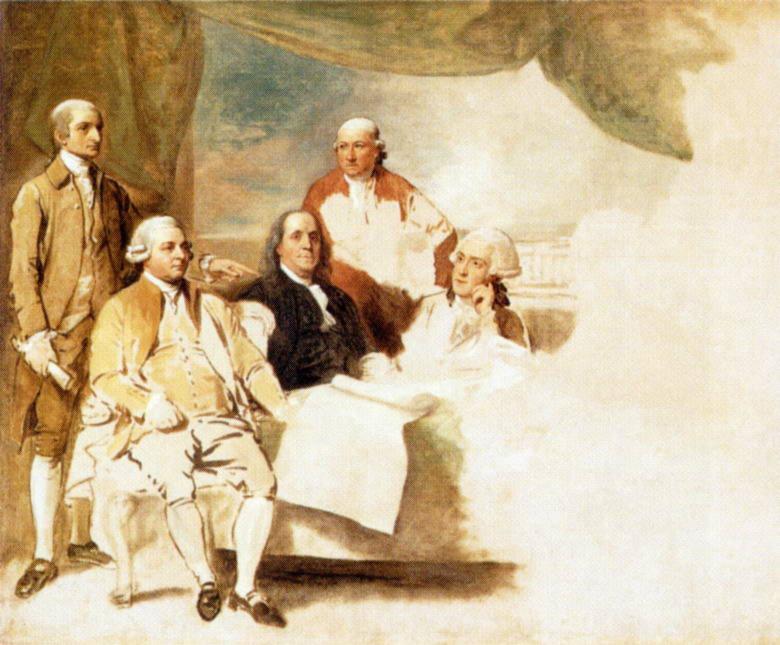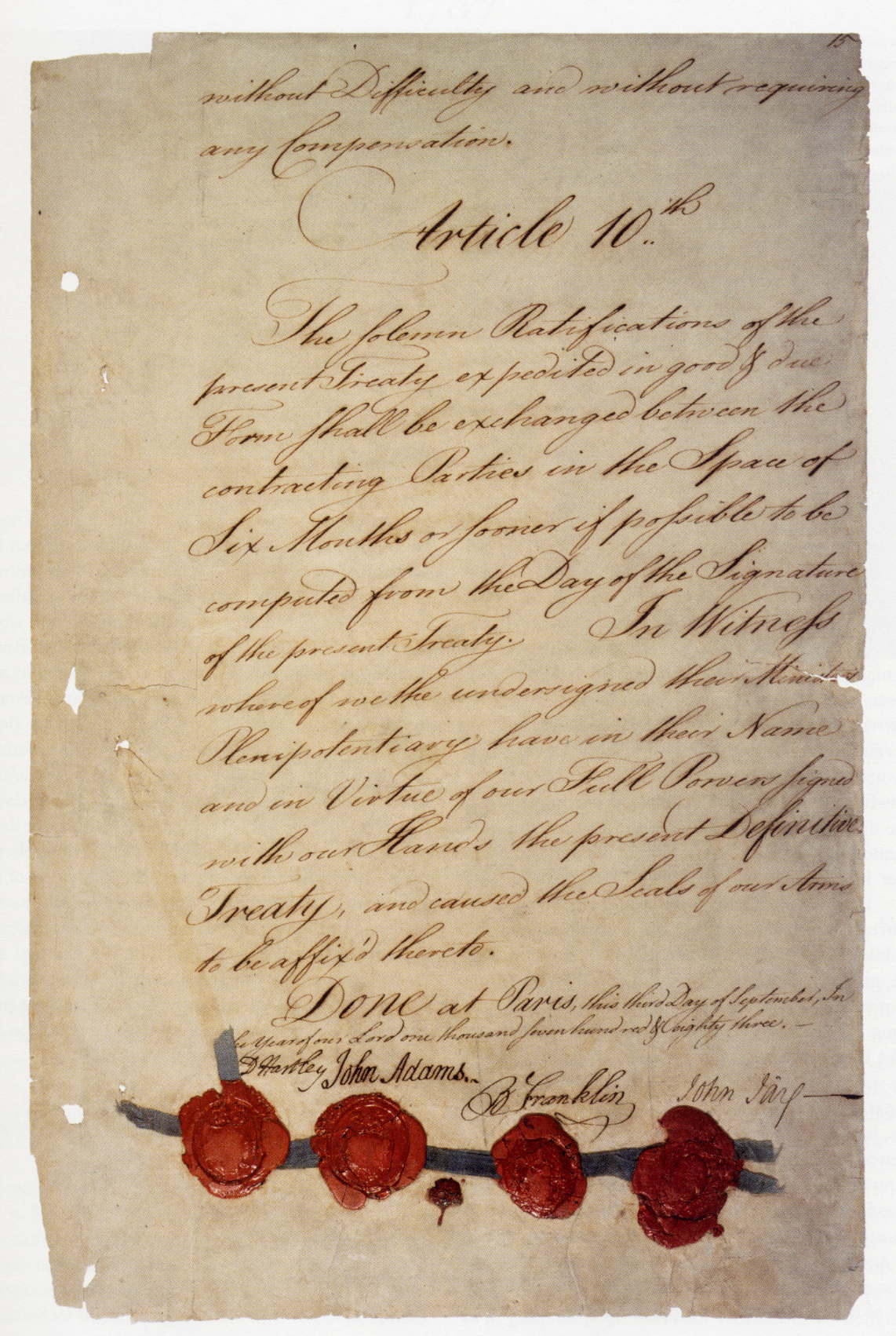The
Treaty of Paris |


|
This painting by Benjamin West commemorates the signing of the peace treaty. It includes, from left to right, John Jay, John Adams, Benjamin Franklin, Henry Laurens, and Franklin's grandson, William Temple Franklin, secretary to the American delegation. West intended for his painting to include the British delegation, but they refused to sit for it. |
| The American War for Independence
was actually a world conflict involving not only the United States and
Great Britain but also France, Spain, and the Netherlands. The peace process
brought a vaguely formed, newly bom United States into the arena of international
diplomacy, pitting it against the largest, most sophisticated, and most
established powers on earth.
The three American negotiators, John Adams, Benjamin Franklin, and John Jay, proved to be masters of the game, outmaneuvering their counterparts and clinging fiercely to the interests most vital to the future of the United States. Two crucial provisions of the treaty were British recognition of U.S. independence and the delineation of boundaries that would allow for American western expansion. This treaty between the American colonies and Great Britain, which four negotiators signed on September 3, i783, ended the American Revolution and formally recognized the United States as an independent nation. The Treaty of Paris is named for the city in which it was negotiated and signed. The last page bears the signatures of David Hartley, a member of Parliament who represented Great Britain, and the three American negotiators, who signed their names in alphabetical order. |
|
In the Name of the most holy and undivided Trinity. It having pleased the Divine Providence
to dispose the hearts of the most serene and most potent Prince George
the Third, by the grace of God, king of Great Britain, France, and Ireland,
defender of the faith, duke of Brunswick and Lunebourg, arch-treasurer
and prince elector of the Holy Roman Empire etc., and of the United States
of America, to forget all past misunderstandings and differences that have
unhappily interrupted the good correspondence and friendship which they
mutually wish to restore, and to establish such a beneficial and satisfactory
intercourse, between the two countries upon the ground of reciprocal advantages
and mutual convenience as may promote and secure to
both perpetual peace and harmony;
and having for this desirable end already laid the foundation of peace
and
reconciliation by the Provisional
Articles signed at Paris on the 30th of November 1782, by the commissioners empowered on each part, which articles
were agreed to be inserted in and constitute the Treaty of Peace proposed
to be concluded between the Crown of Great Britain and the said United
States, but which treaty was not to be concluded until terms of peace should
be agreed upon between Great Britain and France and his Britannic Majesty
should be ready to conclude such treaty accordingly; and the treaty between
Great Britain and France having since been concluded, his Britannic Majesty
and the United States of America, in order to carry into full effect the
Provisional Articles above mentioned, according to the tenor thereof, have
constituted and appointed, that is to say his Britannic Majesty on his
part, David Hartley, Esqr., member of the Parliament of Great Britain,
and the said United States on their part, John Adams, Esqr., late a commissioner
of the United States of America at the court of Versailles, late delegate
in Congress from the state of Massachusetts, and chief justice of the said
state, and minister plenipotentiary of the said United States to
their high mightinesses the States
General of the United Netherlands; Benjamin Franklin, Esqr., late delegate
in Congress from the state of Pennsylvania, president of the convention
of the said state, and minister plenipotentiary from the United States
of America at the court of Versailles; John Jay, Esqr., late president
of Congress and chief justice of the state of New York, and minister plenipotentiary
from the said United States at the court of Madrid; to be plenipotentiaries
for the concluding and signing the present definitive treaty; who after
having reciprocally communicated
His Brittanic Majesty acknowledges the said United States, viz.. New Hampshire, Massachusetts Bay, Rhode Island and Providence Plantations, Connecticut, New York, New Jersey, Pennsylvania, Maryland, Virginia, North Carolina, South Carolina and Georgia, to be free sovereign and independent states, that he treats with them as such, and for himself, his heirs, and successors, relinquishes all claims to the government, propriety, and territorial rights of the same and every part thereof. And that all disputes which might arise in future on the subject of the boundaries of the said United States may be prevented, it is hereby agreed and declared, that the following are and shall be their boundaries, viz.; from the northwest angle of Nova Scotia, viz., that angle which is formed by a line drawn due north from the source of St. Croix River to the highlands; along the said highlands which divide those rivers that empty themselves into the river St. Lawrence, from those which fall into the Atlantic Ocean, to the northwesternmost head of Connecticut River; thence down along the middle of that river to the forty-fifth degree of north latitude; from thence by a line due west on said latitude until it strikes the river Iroquois or Cataraquy; thence along the middle of said river into Lake Ontario; through the middle of said lake until it strikes the communication by water between that lake and Lake Erie; thence along the middle of said communication into Lake Erie, through the middle of said lake until it arrives at the water communication between that lake and Lake Huron; thence along the middle of said water communication into Lake Huron, thence through the middle of said lake to the water communication between that lake and Lake Superior; thence through Lake Superior northward of the Isles Royal and Phelipeaux to the Long Lake; thence through the middle of said Long Lake and the water communication between it and the Lake of the Woods, to the said Lake of the Woods; thence through the said lake to the most northwesternmost point thereof, and from thence on a due west course to the river Mississippi; thence by a line to be drawn along the middle of the said river Mississippi until it shall intersect the northernmost part of the thirty-first degree of north latitude, South, by a line to be drawn due east from the determination of the line last mentioned in the latitude of thirty-one degrees of the equator, to the middle of the river Apalachicola or Catahouche; thence along the middle thereof to its junction with the Flint River, thence straight to the head of Saint Mary's River; and thence down along the middle of Saint Mary's River to the Atlantic Ocean; east, by a line to be drawn along the middle of the river Saint Croix, from its mouth in the Bay of Fundy to its source, and from its source directly north to the aforesaid highlands which divide the rivers that fall into the Atlantic Ocean from those which fall into the river Saint Lawrence; comprehending all islands within twenty leagues of any part of the shores of the United States, and lying between lines to be drawn due east from the points where the aforesaid boundaries between Nova Scotia on the one part and East Florida on the other shall, respectively, touch the Bay of Fundy and the Atlantic Ocean, excepting such islands as now are or heretofore have been within the limits of the said province of Nova Scotia. ... (etc.) Done at Paris,this third day of September in the Year of our Lord one thousand seven hundred and eighty three. D Hartley John Adams B. Franklin John Jay |
![]()
